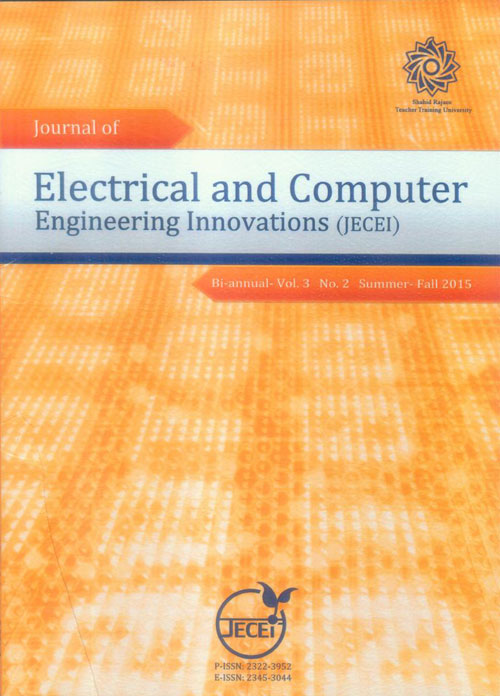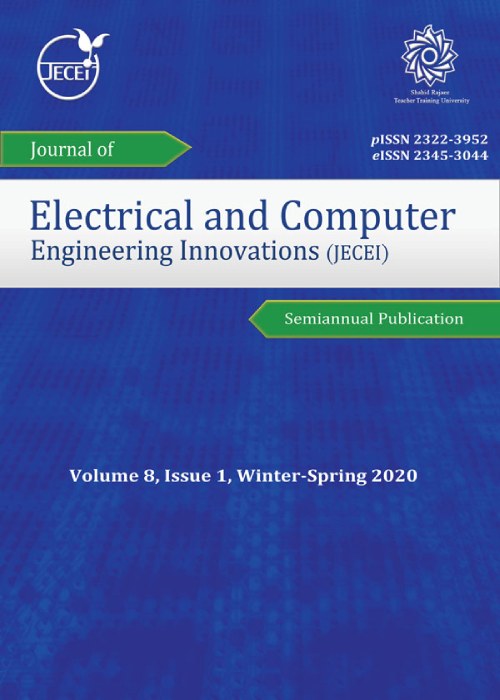فهرست مطالب

Journal of Electrical and Computer Engineering Innovations
Volume:3 Issue: 2, Summer - Autumn 2015
- تاریخ انتشار: 1394/09/30
- تعداد عناوین: 6
-
-
Pages 71-75In this article, a speed control of DC motor is designed and illustrated using fuzzy logic-based programmable logic controller (PLC). The DC motor is an attractive part of electrical equipment in many industrial applications requiring variable speed and load specifications due to its ease of controllability. The designed system is consisted of three main parts including programmable logic controller, pulse width modulation (PWM) bipolar drive and DC motor. In the control section, PLC is used as real time controller and fuzzy logic algorithm is designed based on nonlinear model of DC motor, and its parameters are optimized in MATLAB software. Then, it is implemented using rslogix5000 PLC and programming language ladder for speed control. Finally, with favorable results, the efficiency of the controller is successfully proved under different load conditions. The obtained results demonstrate the efficiency of the PLC intelligent controller in enhancing the accuracy and speed control of DC motor.Keywords: DC motor, Fuzzy logic, Programmable logic Controller, Speed control
-
Pages 77-88Under the smart grid environment, demand response resources (DRRs) are introduced as a virtual power plant to enhance power system adequacy. DRRs often fail to reduce their load due to some external factors. In this paper, a reliability model of a DRR is constructed as multi-state conventional generation units, where the probability, frequency of occurrence, and departure rate of each state can be acquired. DRRs as consequence of demand response program implementation can be applied to transmission congestion management. Therefore, this paper presents an optimal model of congestion management (CM) by means of multi-state DRRs, namely CM_DRR. In the proposed approach, in addition to DRRs, independent system operator relieves the existing transmission line congestions using the combination of generating unit rescheduling and involuntary load shedding. The hourly historical data associated with the Connecticut region in New England is employed to achieve the DRRs participation regime. Moreover, the impact of different capacities of DRRs on the congestion management cost and load shedding cost is evaluated. Results of applying the aforementioned model to the 24-bus Reliability Test System (RTS) indicate the efficiency of CM_DRR framework.Keywords: Congestion management, Demand response resource, Customer's uncertainty, Multi, state model, Smart grid
-
Pages 89-97Axial Flux Permanent Magnet (AFPM) machines are attractive candidates for Electric Vehicles (EVs) applications due to their axial compact structure, high efficiency, high power and torque density. This paper presents general design characteristics of AFPM machines. Moreover, torque density of the machine which is selected as main objective function, is enhanced by using Genetic Algorithm (GA) and variation of PM characteristics, based on sizing equation and Finite Element Analysis (FEA). Then, torque ripple of the motor is reduced according to the effect of PM characteristics on Torque Ripple Factor (TRF). The designed machine produces sinusoidal back-EMF waveform. The torque density is improved and the torque ripple is reduced. The results are validated by using 3D-FEA (FEA) . Furthermore, to assess the obtained results by FEA method, an advanced vehicle simulator (ADVISOR) software is used to demonstrate the performance improvement over the Europe test drive cycles.Keywords: Axial Flux Permanent Magnet, Motor, Finite Element Analysis (FEA), Genetic Algorithm (GA), Torque Ripple Analysis (TRF), Electric Vehicles (EVs)
-
Objects Identification in Object-Oriented Software Development - A Taxonomy and Survey on TechniquesPages 99-114Analysis and design of object oriented is onemodern paradigms for developing a system. In this paradigm, there are several objects and each object plays some specific roles. Identifying objects (and classes) is one of the most important steps in the object-oriented paradigm. This paper makes a literature review over techniques to identify objects and then presents six taxonomies for them. The first taxonomy is based on the documents exist for a domain. The second taxonomy is based on reusable previous knowledge and the third one relies on commonalities in a domain. The fourth taxonomy is concerned with decomposing a domain. The fifth taxonomy is based on experience view and sixth one is related to use the abstraction in a domain. In this paper, the constraints, strengths and weaknesses of the techniques in each taxonomy are described. Then, the techniques are evaluated in four systems inside an educational center in a university. A couple of approach is recommended for finding objects, based on some practical experiences obtained from the evaluation.Keywords: Taxonomy, Class, Object, Object, Oriented, Software Engineering
-
Pages 115-122The Radar Cross Section of a target plays an important role in the detection of targets by radarsý. ýThis paper presents a new method to predict the bistatic and monostatic RCS of coated electrically large objects. ýThe bodies can be covered by lossy electric and/or magnetic Radar Absorbing Materials (RAMs)ý. ýThese materials can be approximated by the Fresnel reflection coefficientsý. ýThe proposed method uses modified Physical Optics (PO) approximation to obtain the object scattered fieldý. ýOne of the advantages is the use of Stationary Phase Method (SPM) to solve the PO integralý. This is becauseýýthe SPM reduces significantly the computation time required to solve this integral as compared to rigorously numerical integration techniquesý. ýSimulationresults are presented to verify the accuracy and efficiency of the proposed method. The results are compared with commercial FEKO and CST software in order to show its superiority as far as the computation time is concerned.Keywords: Asymptotic techniques, Physical optics (PO), Approximation, Radar cross section (RCS), Coated objects, Modified PO
-
Pages 123-129This paper deals with the problem of user-server assignment in online social network systems. Online social network applications such as Facebook, Twitter, or Instagram are built on an infrastructure of servers that enables them to communicate with each other. A key factor that determines the facility of communication between the users and the servers is the Expected Transmission Time (ETT). A smart user-server assignment can avoid the low quality links and improve the communication between nodes and also save the valuable communication resources. Unfortunately, finding the optimal assignment turns out to be a NP-hard problem. This paper proposes the use of a heuristic algorithm named Centralized Simulated Annealing (CSA) to get a good near optimum solution for this problem. Simulation results of this investigation show that using a relatively small number of iterations, this approach achieves a very good performance improvement. On the other hand, the average number of iterations needed to achieve the near-optimal solution, will be slightly increased when the number of users in the network increase.Keywords: Online social networks, Client, server assignment, Centralized simulated, Annealing algorithm


